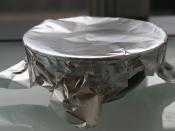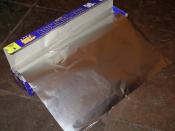Intro: Aluminum or aluminium has an atomic number of 13. Its symbol is Al and it is located in group13 (IIIA), period 3.
History: The story of aluminum started out in England. The year was 1807 when a British scientist named Humphry Davy, discovered a new unidentified element in clay. He tried using electrolysis to isolate the element, but he could only manage to create the white compound this element formed with oxygen. He named it alumina.
In 1825 someone was finally able to isolate aluminum. His name was Hans Christian Oersted, and he was a Danish chemist. He realized that mixing aluminum chloride with a mercury-potassium alloy, and strongly heating the mixture, would make a tiny lump of the pure metallic element we now call aluminum. Unfortunately, this sample was too small for an investigation of its properties to take place.
In 1845, after many years of experimenting with different ways of isolation, a German scientist named Friedrich Wöhler finally produced grains of aluminum large enough to test the metal's physical properties.
Ten years later, a Frenchman named Henri Sainte-Claire Deville entered a shiny piece of aluminum in the Paris Exhibition. Napoleon the Third was so impressed that he asked Sainte-Claire Deville to find a way of making the metal cheaply. Napoleon intended for his army to sport equipment made of this wonderfully light metal, but it was very costly. This set scientists on the pursuit to manufacture aluminum economically, but no easy way could be found, and the metal became more precious then gold. Napoleon is said to have had a set of aluminum cutlery made for his most honored guests.
Nowadays, aluminum is acquired from bauxite. Bauxite is an ore that has large quantities of a compound named alumina.
Characteristics:Aluminum is a soft, light, silvery metal. The...


